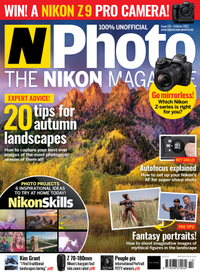How to make a multiplicity photo in Affinity Photo – N-Photo 155 video tutorial
Combine several portraits of the same subject to master essential layer masking skills and create a magnificent multiplicity photo
Trouble streaming the above video? View/download it here
The multiplicity effect is a fun way to combine several different portraits into one. It’s a great one to try out with your own set of portraits, and the shooting technique is very simple. All you have to do is use a tripod to keep all the frames in alignment, then photograph your subject in different positions around the frame. Keep the camera settings and lighting consistent throughout, and try out different poses. You can take it further by having your ‘clones’ interact with one another, or by experimenting with a shallow depth of field as we’ve done here, so that the figures behind our main portrait become more and more blurry.
The technique for editing our set of photos is very easy. We begin by opening the set as a stack of layers in Affinity Photo. There isn’t a dedicated feature that lets us do this automatically, but we can use a simple hack with the ‘New Stack’ command. The command is designed primarily for removing objects from multiple images, which is sort of the opposite of what we want here. But to get around this all we have to do is ungroup the stack, and we’ll have a set of layers to work with (handily pre-aligned for us).
From here, we then paint simple layer masks. If you’re new to layer masking, it’s a gentle introduction to this essential editing feature in Affinity Photo. By painting masks, it takes just a few moments to blend our six starting images into our final ‘impossible’ image. Here we go…
Download the project file(s) to your Downloads folder
N-Photo: The Nikon Magazine is a monthly magazine that's written by Nikon enthusiasts for Nikon enthusiasts, you can be sure that all the content is 100% relevant to you! So for the best Nikon-focused news, reviews, projects and a whole lot more, subscribe to N-Photo today – with our unmissable sub deal!
Get the Digital Camera World Newsletter
The best camera deals, reviews, product advice, and unmissable photography news, direct to your inbox!
The lead technique writer on Digital Camera Magazine, PhotoPlus: The Canon Magazine and N-Photo: The Nikon Magazine, James is a fantastic general practice photographer with an enviable array of skills across every genre of photography.
Whether it's flash photography techniques like stroboscopic portraits, astrophotography projects like photographing the Northern Lights, or turning sound into art by making paint dance on a set of speakers, James' tutorials and projects are as creative as they are enjoyable.
He's also a wizard at the dark arts of Photoshop, Lightroom and Affinity Photo, and is capable of some genuine black magic in the digital darkroom, making him one of the leading authorities on photo editing software and techniques.


